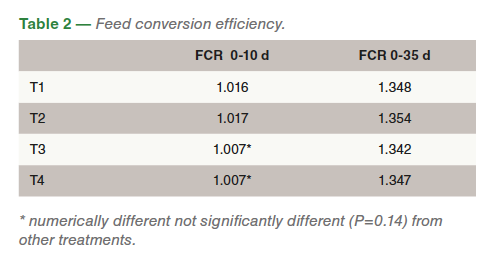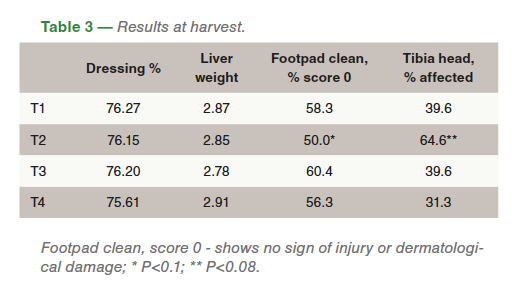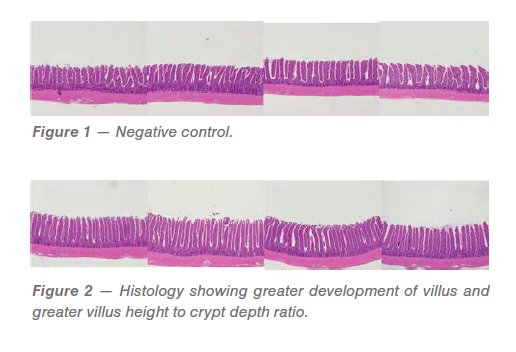
In this study the specific interventions of chelated copper methionine hydroxy analogue (cuMHAC) and a combination of cuMHAC and an effective foregut acidifier were tested on broiler chickens.
Summary

The treatment effects were studied against birds fed diets containing antibiotics or no treatment. The negative control containing no antibiotics performed as well as the antibiotic and cuMHAC, with no significant treatment effect found in any performance indicators including growth, feed intake, carcase weight or feed conversion efficiency. The treatments including cuMHAC alone and cuMHAC with acid water resulted in less feed required to reach equivalent bodyweight to other treatments in the first 10 days of growth. Performance by day 35 was equal across all treatments. Significant differences in intestinal architecture were found between negative control which had least villus to crypt ratio P<0.01 compared to all other treatments. Foot pad lesions were least evident in the antibiotic treatment and in both cuMHAC treatments. No treatments had significant deviation from antibiotic control in flock uniformity, antibody titer response, intestinal bacterial enteritis score, carcase weight and dressing percentage, salmonella counts in litter or litter score in this study.
Introduction

The following statement was made by Landers et al. (2012) in a public health report. “Although the majority of antibiotic use occurs in agricultural settings, relatively little attention has been paid to how antibiotic use in farm animals contributes to the overall problem of antibiotic resistance”. Some classes of antibiotics are becoming less effective due to overuse and microbial adaptation leading to resistance to treatment. The pool of available, effective antibiotics is shrinking as this resistance increases. The European Union, Thailand and Indonesia are some of the largest food producing jurisdictions that have banned or restricted the prophylactic use of antibiotics as a growth promoter in all animal production. There is already restricted use in Mexico, Japan, South Korea and Vietnam with more countries planning phase out of antibiotics with China pledging to ban AGPs in the next 5 years. Routine addition of antibiotics in broiler feed to reduce disease incidence and improve efficient growth is now banned in many jurisdictions globally. As producers look to a reliable antibiotic alternative, it is clear, as shown by Dibner and Richards (2005), that no single intervention will support the immune system and growth of broilers independently. Alternatives to antibiotics are being used and sought to ensure the health and performance of broilers, layers and other farmed species across the world. There are many feed ingredient alternatives that have been tested and shown variable responses. Mehdi et al. (2018) cited the following “among these, the most popular are probiotics, prebiotics, enzymes, organic acids, immunostimulants, bacteriocins, bacteriophages, phytogenic feed additives, phytoncides, nanoparticles and essential oils”. Second only to the trace mineral zinc in enzyme regulation, copper has been shown to have a positive effect on broiler health. Yazdankah et al. (2014), in a paper concerned with microbial co-resistance, noted super-dosing of copper in inorganic forms such as copper sulphate is used routinely in both swine and broiler operations. In addition to the importance in cellular respiration, antioxidant function and iron transport, copper supports the immune system where neutrophils rely upon the ‘respiratory burst’ to generate free radicals such as superoxide (O2 −), which kill engulfed pathogens (Suttle, 2010).
Methods
A total of 672 male Arbor Acres Plus broilers were randomly assigned to one of 4 treatments (Table 1). This consisted of 168 birds in each treatment in 8 pens containing 21 birds each. These birds were fed for 35 days and then processed. Birds were housed on re-used litter. Diets were based on corn and soy bean meal containing maximum 7% corn DDGS with 3.4% meat and bone meal. All diets were identical in makeup except the cuMHAC treatments which were balanced for methionine content and contained no supplemental inorganic copper.

Treatment one contained the antibiotic zinc bacitracin as positive control. Treatment twocontained no antibiotic or other additive. Treatmentsthree and four included copper in the form of cuMHAC at 30ppm. In treatment four, water acidification was achieved using a blend of liquid methionine hydroxy analogue, formic and propionic acid at 0.2 ml per litre to achieve a drinking water pH of four. Measurements taken at the beginning of the study were litter score, flock uniformity, diet proximate analysis and litter score for Salmonella levels. Microbiota analysis was done by sacrificing 1 bird per pen at 21 days and collecting ileum contents. These samples were tested for Lactobacillus and Clostridium content. Histology samples were also fixed at this time. Antibody titration against Newcastle disease (ND) using hemagglutination inhibition (HI test), infectious bronchitis (IB) (HI test) and infectious bursal disease (IDB) (ELISA) was measured in 2 birds per pen at 28 days. Intestinal health was scored by an independent veterinarian at 35 days on 2 birds per pen at processing. Carcase measurements at processing included carcase yield, foot pad lesions, tibial head lesions and liver weight. Statistical analysis was conducted using Duncan’s multiple range test where P<0.05 was considered to be significant.
Results
As seen in Table2, although there was a numerical advantage for the cuMHAC treated groups in FCR at 10 days, no treatment resulted in significant improvement to bodyweight, feed conversion or uniformity by day 35 of the study.

Results at 21 days when small intestine contents were analysed for Lactobacillus spp and Clostridium perfringens content showed numerical differences across treatments with cuMHAC treatments trending higher for both colonies but no statistically significant differences and with no differences seen between antibiotic and negative control groups. This suggested little to no challenge to intestinal health; this was reinforced with no difference seen in bacterial enteritis score, antibody titre response or litter Salmonella count between treatments. Thofner et al. (2019) discuss the use of foot pad lesions as a measure of welfare. Both foot-pad lesions and tibial head lesions are typical health concerns in modern broiler production leading to lameness, ethical destruction or a reduction in healthy pieces including saleable paws (feet) at processing. Interesting trends emerged in this study among the treatment groups with foot pad lesions least evident in antibiotic treatment and in both cuMHAC treatments while negative control had numerically (P<0.1) fewer healthy (score zero) lesions. This trend continued for tibial head lesions where incidence tended to be greater in the negative control group (39% higher incidence P<0.8) than in the antibiotic control. All carcase pieces and organ weights were similar.
Significant differences in intestinal architecture were found between negative control which had least villus to crypt ratio (P<0.01) compared to all other treatments as seen in Table 4.
Discussion

Although the study was conducted in an environment which had been designed to allow potential for antimicrobial activity due to a moderate degree of performance pressure, the birds remained healthy. The birds were housed on re-used litter, offered feed with maximum levels of DDGS and MBM and were held at maximum pen density. This study did give an excellent indication of how the cuMHAC fed birds responded when very little performance pressure was applied. The key indicator of the healthy flock was the equivalent performance of the negative control treatment T2 to the zinc bacitracin fed group T1. The only area of difference between the antibiotic treatment and control was in the tibial head lesion score (P<0.08) which might suggest some level of gut barrier failure. Results from this study suggest that the most consistent performance improvement can be gained by including copper hydroxy analogue or copper hydroxy analogue with an effective foregut acidifier. Arbe and Bekker (2017) showed how inclusion of copper methionine hydroxy analogue could increase the performance of broiler birds at lower inclusion levels than inorganic salts and Hassan et al. (2010) showed the benefit of organic acid inclusion without an antibiotic growth promoter which supports the trends seen in this study. The other notable trend was for birds that grew more efficiently during the critical first 10 days to have greater carcase integrity at 35 days, resulting in healthier foot pads and tibia joints with fewer lesions.
References are available on request
From the Proceedings of the Australian Poultry Science Symposium 2020

















